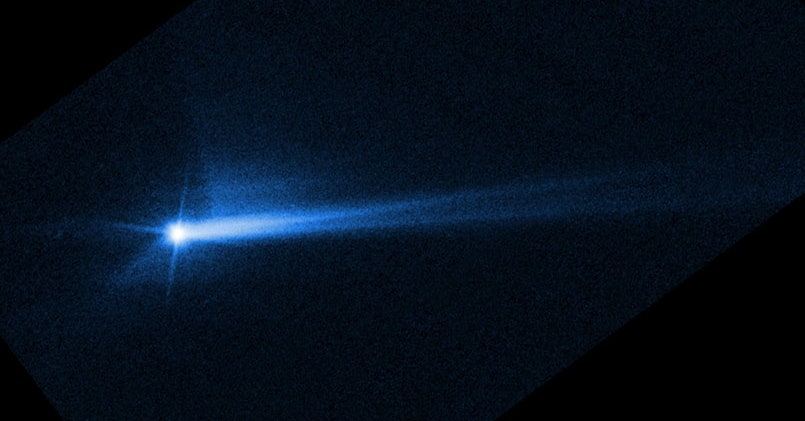
Nearly one year ago, NASA flung the DART spacecraft into the asteroid Dimorphos at 14,000 miles per hour. It was the first test to see whether they could slightly deflect a space rock’s trajectory using a high-speed collision, a technique that could be used to protect Earth from future killer asteroids. It worked. But now they’re trying to figure out the details of the crash. And if people have to defend earthly life from a potential asteroid impact, those details will surely matter.
Scientists are starting by studying the ejecta, boulders, and numerous smaller bits the strike cast off. They predicted there would be debris, but they didn’t know exactly what to expect. After all, compared to stars and galaxies, asteroids are tiny and dim, so it’s hard to ascertain their density and composition from afar. When you strike one, will it simply bounce? Will the probe thud into it and create a crater? Or if the asteroid is brittle, will slamming a craft into it risk creating space shrapnel that is still big enough to threaten Earth?
“This is exactly why we needed to do an in-space test of this technology. People had done laboratory experiments and models. But how would an actual asteroid, of the size we’re concerned about for planetary defense, react to a kinetic impactor?” says Nancy Chabot, the DART coordination lead and a planetary scientist at Johns Hopkins University’s Applied Physics Laboratory, which developed the craft in partnership with NASA.
Many asteroids appear to be “rubble piles,” dirt, rocks, and ice loosely held together, rather than something hard and dense like a billiard ball. The asteroid Ryugu, visited by the Japanese space agency’s Hayabusa2 in June 2018, and the asteroid Bennu, which NASA’s OSIRIS-REx took samples from in 2020, both count as rubble piles. A new study published in July in Astrophysical Journal Letters shows that Dimorphos appears to be built like that too, which means that an impact is likely to create a crater and to fling off debris on or near the asteroid’s surface.
To figure out what happened after the crash, David Jewitt, a University of California, Los Angeles astronomer, and his colleagues used the Hubble Space Telescope to zoom in repeatedly on Dimorphos. The combined deep observations allowed them to discern objects that are otherwise too faint to see. A few months after the DART probe’s impact, they found a swarm of about three dozen boulders not seen before—the largest of which is 7 meters in diameter—slowly drifting away from the asteroid. “It’s a slow-speed cloud of shrapnel from the impact that’s carrying away a significant amount of mass: about 5,000 tons in boulders. That’s quite a lot, considering the impactor itself was only half a ton. So it blew out a tremendous mass in boulders,” Jewitt says.
Other researchers, including the DART team, have also been investigating the cloud of rocks thrown off by the spacecraft’s swift punch. Chabot and her colleagues published a study in Nature earlier this year, also using Hubble photos, imaging the ejecta. They showed that at first the pieces flew off in a cone-shaped cloud, but over time, that cone turned into a tail, not so different from a comet’s tail. That finding also means that models of the behavior of comets could be applied to impactors like DART, Chabot says.
Dimorphos was never a threat to Earth, but details like these would matter in a real asteroid deflection scenario. Boulders and smaller ejecta would have to be knocked out of the way, along with the rest of the asteroid, in order to spare the planet. Or let’s say the asteroid wasn’t spotted until it was very close to Earth, and its trajectory couldn’t be altered enough to avoid a crash. Could it at least be pulverized into boulders small enough to burn up in Earth’s atmosphere? “Is it better to be shot by a high-velocity rifle bullet or a bunch of pellets from a shotgun?” asks Jewitt. “The answer is: The shotgun is better, because the smaller boulders are more likely to be cushioned or dissipated by the impact with the atmosphere.”

